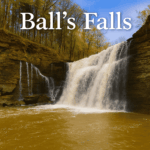If you want a clear understanding of the remarkable development behind the balls of the falls in Niagara, Canada, start by exploring their origins and purpose. These unique structures, designed to protect the falls’ natural beauty while preventing ice buildup during harsh winters, have a long and intriguing history rooted in engineering ingenuity and environmental awareness.
Initially introduced in the early 20th century, the balls of the falls were created to address the challenge of ice accumulation that threatened both safety and the scenic environment. Over the decades, their design evolved, incorporating materials and techniques to improve durability and effectiveness. Today, they stand as a testament to the ongoing efforts to preserve Niagara’s iconic waterfall while balancing ecological preservation and tourism needs.
Understanding the timeline and technological advancements in the balls of the falls construction reveals how innovative solutions can help maintain natural landmarks like Niagara. From the first installation to recent upgrades, their history reflects a constant drive to protect this world-famous destination in Canada, ensuring future generations can continue to enjoy its breathtaking views.”
Engineering Techniques and Materials Used in Building the Balls of the Falls
Builders of the Balls of the Falls in Ontario relied on precise engineering methods to ensure durability and safety. They used reinforced steel frameworks to support the large spheres, preventing deformation under environmental stress. The steel was carefully shaped and welded to create a seamless, robust structure that could withstand harsh Niagara weather conditions.
For the exterior, engineers chose durable materials like brick and concrete to cover the steel frame. The brickwork was laid with meticulous attention to alignment, providing added strength and aesthetic appeal. The concrete was mixed with specific aggregates that resist cracking and weathering, extending the lifespan of the structures.
Innovative welding techniques enabled secure connections between steel elements, creating a unified frame that distributes loads evenly. This approach minimized the risk of structural failure, especially important for the iconic Balls of the Falls that endure constant exposure to moisture and temperature fluctuations.
In some sections, lightweight yet sturdy materials such as aluminum panels were incorporated to reduce overall weight without sacrificing strength. This optimization helped in stabilizing the spheres while facilitating maintenance and access points.
Overall, combining steel reinforcement, weather-resistant brick and concrete, along with strategic use of lightweight panels, allowed the construction of the Balls of the Falls to meet demanding engineering standards. These choices ensure the structures remain resilient and impressive for generations along the Niagara region.
Challenges Faced During Construction and How They Were Overcome
During the construction of the Balls of the Falls in Ontario, workers encountered significant logistical hurdles due to the site’s proximity to Niagara Falls. Unpredictable weather conditions, especially heavy rain and strong winds, threatened to delay the project and damage delicate components. To counter this, construction teams adjusted their schedules, prioritizing work during favorable weather windows and reinforcing temporary structures to withstand harsh conditions.
Transporting large, heavy materials across the rugged terrain proved complex, especially given the area’s high traffic along Niagara routes. The project manager coordinated with local authorities to secure specialized transportation permits and used reinforced trucks to move components safely. This proactive approach minimized delays and ensured timely delivery of essential parts.
Securing reliable power sources and stable utilities in a partially remote location led to frequent power outages, disrupting construction progress. Teams installed temporary generators and collaborated closely with local utility providers to guarantee consistent electricity flow, reducing downtime and maintaining steady workflow.
Additionally, preserving the natural environment of Niagara was a priority, requiring careful planning to prevent ecological disturbances. Eco-friendly construction practices, such as waste management protocols and minimizing site excavation, helped address environmental concerns while maintaining project momentum.
By adopting meticulous planning, flexible scheduling, and close cooperation with local authorities and specialists, the teams successfully navigated these obstacles. As a result, the Balls of the Falls project advanced efficiently despite the inherent challenges of building near one of Ontario’s most iconic landmarks.
Impact of the Balls of the Falls on Local Infrastructure Development
The construction of the balls of the falls significantly influenced the growth of Niagara’s infrastructure in Canada. The increasing visitors drawn by this attraction prompted local authorities to enhance transportation systems, including roads and bridges, to accommodate the surge in traffic. These developments connected the attraction more efficiently with surrounding communities, boosting commerce and accessibility.
Transportation and Public Services Improvements
As visitors flocked to see the balls of the falls, Niagara’s public transit networks expanded. Bus routes extended to include nearby hotels and observation points, while parking facilities increased capacity. Enhanced signage and safety features also emerged to improve visitor experience and safety around the site.
Urban Development and Community Growth
The popularity of the balls of the falls spurred local urban development in Niagara, Canada. New accommodations, restaurants, and retail outlets opened to serve the influx of tourists. Infrastructure upgrades, such as water and sewage systems, also ensured these developments operated smoothly and sustainably, supporting long-term community growth driven by tourism related to the attraction.

